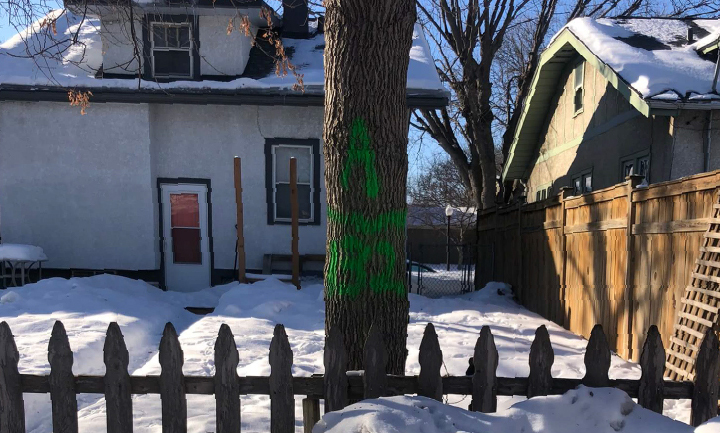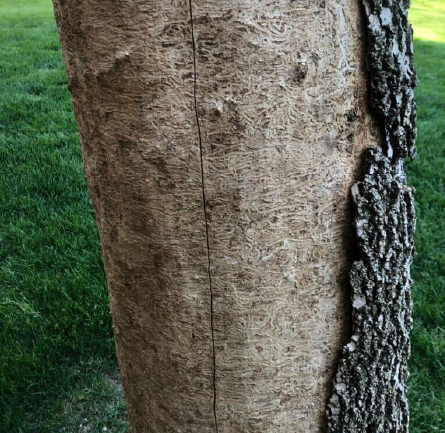
Ask anyone around before the arrival of Dutch elm disease in the 1960s, and they’ll regale you with descriptions of majestic elms arching over streets from both sides. Although most old elms are long gone, you can still find them in isolated locations. That isolation protected them from Dutch elm disease; now they stand as relics of a simpler time. With the benefits of our modern, global supply chain also come insects and diseases. Many of these have become invasive across the world.
Much like the Spanish Flu, the COVID-19 pandemic forced us to learn more about epidemiology than we’d like. One benefit is that it allowed us to explore new management strategies. Insects and diseases spread and damage trees in different ways. Some issues are preventable; others have no treatment at all.
The most extreme example of forced action require the removal of a tree. This option is usually reserved for two situations. The first is if the tree has a compromised structure and poses a risk to life and limb. This may include condemning ash trees damaged by emerald ash borer. The second is if the repercussions of the spread of the disease are too high to allow the tree to stay up. The most common examples of this are Dutch elm disease and oak wilt. In all cases, the municipality must balance the property owner’s rights against the hazard posed to the public.
Property owners may have some options other than removing condemned trees. This is dependent on the issue and the condition of the tree. For example, ash trees may be treatable depending on the extent of the infestation. But American elms infected with Dutch elm disease must be cut down and removed. Oak wilt has a bit more nuance and is very dependent on which species the oak in question is. If your tree has a paint mark, consult an arborist to explore all your options.


The emerald ash borer was first discovered in the US around Detroit, Michigan in 2002. It likely hitched a ride on ash wood from northern Asia used for packaging. The emerald ash borer spread throughout the Midwest and was first observed in Saint Paul in 2009, but it has thus far been less destructive in Minnesota than in Ohio and Michigan. Our much colder winters kill more larvae each winter than in areas to the east. We also had advanced warnings and better treatment options when it arrived. However, the population is building, and the ongoing drought is speeding up tree decline. The southeast metro had many trees showing a significant decline this summer.
Ash trees here in the Twin Cities are often condemned for two reasons. The first is to encourage property owners to protect the tree with tree care treatment. Tree care is most successful when performed early. Condemnation forced many residents to adopt their boulevard trees or replace them. Tree inspectors have now shifted their focus to trees on private property. When trees have paint marks, a treatment plan can rescind the condemnation order.
The second reason to condemn an ash is when the tree shows symptoms of infestation. The decline we see in non-treated ash creates a hazardous situation for arborists. Several arborists have died when the trees they were removing failed. Proactive condemnation ensures that removal will happen before too much structural damage occurs.
Dutch elm disease and oak wilt are fungal diseases affecting a tree’s vascular system. Both can spread overland, vectored by insects, as well as via root graft connections. Dutch elm disease burned through the 1970s, killing three-quarters of boulevard trees. This epidemic had very similar uncertainties to the COVID-19 pandemic. We watched as countries adopted strategies to limit the spread of COVID-19. As the varying effects are evident today, the ways in which municipalities approached DED are apparent in the number of remaining elms. This article by the Minnesota Historical Society accounts for what happened in those years.
In some circumstances, catching Dutch elm disease early enough can save a tree. If it hasn’t yet spread into the trunk, treatment and pruning may be able to cut out the infection. Success depends on immediate action; even one day can mean the difference. Contact an arborist immediately if your elm has a paint mark. Preventative treatment is the best measure to protect the few large elm trees left.
Oak wilt often pops up in pockets throughout undeveloped forested areas. It is usually not a significant cause for condemning urban trees but can be more of an issue in outer-ring suburbs. Managing oak wilt risk is still essential, particularly for our most enormous specimen oaks. The ongoing drought has increased stress on trees, which may lead to more issues with oak wilt in the years to come. We will be exploring oak wilt in-depth in our next arborist blog.
If your tree has been marked, it’s essential to be proactive. If you know you have an ash, elm, or oak, consider preventative treatment to protect your tree. Contact our ISA Certified Arborists or Board-Certified Master Arborists to discuss options for your tree.
From questions to estimate requests, contact us about your residential or commercial project.
2504 25th Ave S
Minneapolis, MN 55406
612-872-0205
trees@vinelandtree.com
© 2025 Vineland Tree. All Rights Reserved.